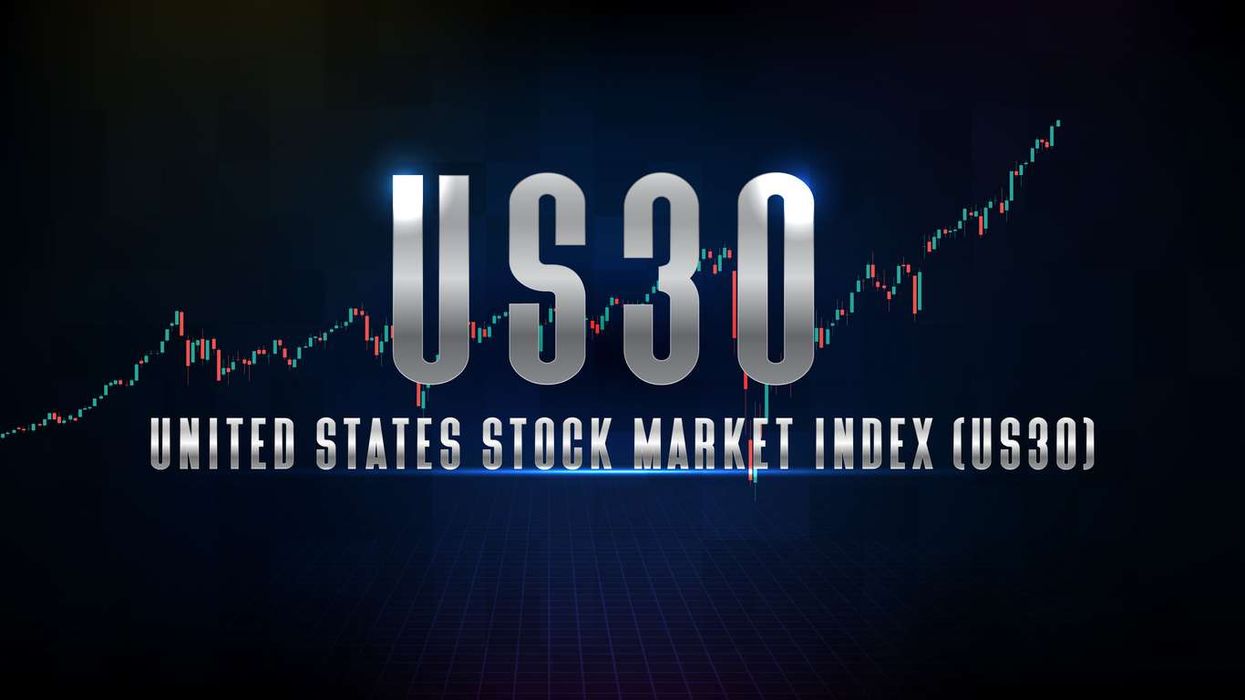The US30 Index, more commonly known as the Dow Jones Industrial Average (DJIA), is one of the world’s most closely watched stock market indices. The current volume sits at $484,930,271, and a day's average is 45,862.37 - 46,327.07.
It's a massive market that quickly became an indicator for the global economies' next moves. Read on to find out more.
The US30 Index Explained
The US30 Index tracks 30 of the largest and most influential US companies. They're blue-chip firms spanning sectors from technology and finance to healthcare and consumer goods. It includes sector-leading companies such as
- Apple
- Microsoft
- Goldman Sachs
- Johnson & Johnson
And 26 more to make the US30, all listed on platforms such as Exness. The US30 is a big indicator for the health of the US and global economy. When the Dow rises or falls, it often reflects investors’ collective outlook on economic conditions.
One unique aspect of the US30 is its price-weighted design. Unlike indices such as the S&P 500, which are weighted by market capitalization, the Dow gives more influence to stocks with higher share prices. It doesn't matter about a company's total size. This means a price swing in a high-priced stock—for example, Goldman Sachs—can move the index more than an equal-percent swing in a lower-priced stock.
Yes, this method has its critics, but the US30’s composition of top-tier companies still makes it highly representative of the US industrial and corporate landscape. It has stood for over a century, founded in 1896, as an iconic gauge of American business.
The US30 is at a critical decision point.
The Dow Jones Industrial Average's long-term ascent in 2024 surpassed previous peaks around 36,000 and 40,000 before reaching new record highs in the mid-40,000s by late 2024. Now in late 2025, the index sits near these highs, teetering between breakout and pullback, currently sitting on a weekly high average of 47,049.64.
Maybe we’ll see a reversal flag pattern with a potential negative change in market direction. If you track the patterns on platforms like Exness, the patterns over the next one month trading window will tell us which way the market is likely to go heading into 2026.
After a strong multi-year run, the DJIA is at a critical decision point. The index has been testing record highs in 2025, but recent market action suggests a tug-of-war between bullish momentum and emerging risks.
In mid-October 2025, the Dow pulled back from fresh highs. It seems like traders are eyeing key technical levels to gauge its next move. A recent drop below the 46,000 mark did cause a dip in the market’s confidence, putting the spotlight on support around 45,300. That's a level that analysts consider critical to keep the uptrend intact.
If the Dow were to fall through that support, it could signal a deeper correction. There's a potential for it to go down toward the mid-44,000s.
Speaking positively, there is now tough resistance around 46,600. That's a reclaim of a level that is seen as necessary for the index to get back on track and resume its bullish trajectory, according to industry experts.
The Factors Attributing to the DJIA Inflection Point
Stretched Valuations vs. Earnings Delivery
The powerful rally through 2023–2024 has left stock valuations quite elevated. As of late 2024, the S&P 500 (a broader index) was trading around 22× forward earnings. These are levels rarely seen outside of late-1990s or post-2020 bubbles. The Dow, with its heavy weighting in established blue chips, isn’t as tech-heavy as the S&P, but it does reflect rich valuations after its climb.
Technical Momentum vs. Reversal Risks
From a chart perspective, the Dow has experienced a steady uptrend despite periodic corrections since the last bear market bottom in 2022. By 2025 it is late in the bull market cycle, raising questions about how long the momentum can continue. Recent divergences—such as weakening breadth or losing upside momentum indicators—hint at possible exhaustion.
Bulls have largely been in control, but they are now defending major support at 45,300 to prevent a trend reversal.
Macro and Policy Uncertainties
The environment around the Dow has become more uncertain. Interest rate policy is in flux. After aggressive tightening earlier, the Fed eased off with rate cuts in late 2024. But in 2025, it paused further cuts as inflation progress stalled around 3% and unemployment leveled near 4%, now at 4.3%. With rate cuts essentially on hold and no clear signal of monetary stimulus, stocks lack a certain tailwind they had gotten used to.
Tightening Interest Rates and Strong Earnings Growth
One of the defining features of the late-2024 to 2025 market landscape has been the clash between tight monetary policy and strong corporate earnings.
Going into 2024, interest rates were at their highest levels in over a decade at 5.14%. By late 2024, the Fed finally pivoted to cutting rates, reducing the federal funds rate by almost a full percentage point in total across the November and December 2024 meetings. This brought the Fed’s target rate down into the mid-4% range, now sitting at 4.25%. It's still elevated by historical standards but lower than the peak.
And despite that, officials have been in no rush to deliver more cuts because core inflation has been sticky, sitting at just over 3%, and the economy remains solid.
Many companies have been able to grow their profits despite the higher cost of capital. Strong consumer demand and operational efficiencies have helped. In fact, even as 10-year Treasury yields held in a roughly 4–5% range—far above the near-zero yields of the late 2010s—equity markets advanced.
Analysts at US Bank pointed out in September 2025 that “even though interest rates may be relatively high, solid corporate earnings growth supports equity prices.” This dynamic has played out in the Dow. Corporations have generally beaten earnings expectations in recent quarters, reassuring investors that higher financing costs aren’t derailing profitability.
What the US30 Index Is Telling Us About the Global Economy’s Next Moves
Watching the DJIA's behavior over the past year gives clues about the global economy’s direction.
The Dow’s record highs and recent wobbles mirror the broader economic story. Resilient growth with undercurrents of uncertainty. The very fact that the Dow has been hitting all-time highs in 2025 tells us that the economic expansion post-pandemic has been stronger and longer-lived than many expected.
Despite widespread predictions of a recession, the US economy has continued to grow at an above-trend pace. For example, the US GDP expanded by about 3.1% annualized in Q3 2024. This strength has underpinned the stock market’s rise. The US30’s surge in late 2024, when it crossed 45k, and its steady gains in 2025 signaled confidence in ongoing economic growth both in the US and globally.
Investors appeared to be pricing in a soft landing scenario. Inflation coming under control without strangling growth, and global demand remaining robust. And by mid-2025, consumer spending and business investments were holding up well in the US, and Europe and other regions, while slower, were managing to avoid contraction.
The Dow’s upswing reflected this surprising economic resiliency, suggesting that the global economy’s next move was not a downturn but rather a continued, if moderate, expansion.
And it always rebounds relatively fast. When a tentative détente was reached later in October after tariff increases—when tariff threats paused and talks resumed—the Dow rebounded by 711 points in a week. Some would say it suggests that if trade conflicts abate, the global growth outlook brightens.
The US30 Index, like the S&P 500 and the Nasdaq-100, is a great indicator of the US and global economic health. And looking at the levels of resistance it's holding at, it seems the global economy is ready to see a breakout.





 Mareyah Bhatti , a sustainability strategist and passionate home cookMareyah Bhatti
Mareyah Bhatti , a sustainability strategist and passionate home cookMareyah Bhatti







Anurag Bajpayee's Gradiant: The water company tackling a global crisis